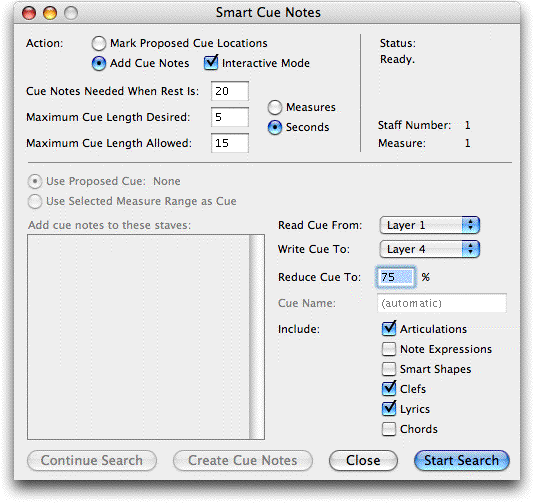Smart Cue Notes Plug-in

How to get there
Choose  > Scoring and
Arranging > Smart Cue Notes.
> Scoring and
Arranging > Smart Cue Notes.
What it does
The Smart Cue Notes plug-in can search
for possible cue note locations and mark these locations in the score.
Then, cue notes can be added to these locations automatically.
Tip. For optimal performance, we recommend moving to Scroll
View (View menu > Scroll View) before running this plug-in.
- Mark
Proposed Cue Note Locations In Score. Choose this option to add text blocks
that flag possible locations where cue notes would be appropriate. The
text blocks include the number of seconds of rest for the staff/part.
- Add
Cue Notes · Interactive Mode. Choose Add Cue Notes to place cue
notes into the document where appropriate as defined by settings in this
box. Check Interactive Mode to first search for cue notes, and then create
them for specific staves, using additional options if desired. If interactive
Mode is not checked, clicking OK adds all cue notes without pausing to
set additional options.
- Cue
Notes Needed When Rest Is _ · Seconds · Measures. In this text
box, enter the number of Measures or Seconds required for Smart Cue Notes
to mark and/or add cue notes. (With Seconds chosen, timing adjusts to
meter changes).
- Max
Cue Length Desired _ Allowed _. Cue notes are generally added to
the phrase prior to the entrance. For Desired, enter the desired number
of measures or seconds to scan prior to an entrance for the beginning
of a phrase. If Smart Cue Notes does not find a phrase within the Desired
number of measures or seconds, it will add cue notes with as many measures
or seconds entered in the Allowed text box.
- Use
Proposed Cue. Choose this option to copy the cue notes proposed
by Smart Cue Notes plug-in to the staff or staves chosen in the list below.
- Use
Selected Measure Range As Cue. Choose this option to copy the notes
within a region selected with the Selection tool as cue notes to the staff
or staves chosen in the list below.
- Add
This Cue To These Staves. In this list, choose the staff or staves
you would like to add the cue notes to.
- Read
Cue From. From this pop-up menu, specify the layer containing
the source material.
- Write
Cue To. From this pop-up menu, specify the layer to write
the cue notes to.
- Reduce
Cue To _ %.In this text box, enter the notehead percentage reduction
(relative to the default notehead size) for the generated cue notes.
- Cue
Name. In this text box, specify a name for the generated cue notes.
This text, which appears as the source staff name by default, will appear
as an expression above each section of cue notes added to the document.
- Include:
Articulations · Expressions · Smart Shapes · Clefs · Lyrics · Chords.
Check any of these items to include them on cue notes copied from the
source staff.
- OK
· Start Search. The OK button is available when Interactive Mode
is unchecked. Click OK to scan the document for possible cue note locations
and add them automatically. The Start Search button is available when
Interactive Mode is checked. Click Start Search to scan the document for
possible cue note locations. The Smart Cue Notes plug-in will then pause
to allow for specifying staves and setting other options.
- Create
Cue Notes. Available after choosing Start Search (with Interactive
Mode checked). Click this button to add cue notes to the staff and measure(s)
specified in the Cue Options section.
- Continue
Search. Available after choosing Start Search (with Interactive
Mode checked). Click this button to advance to the next proposed cue note
location.
- Cancel.
Available while processing measures. Click to interrupt a search for cue
note locations and return to the Smart Cue Notes dialog box.
- Done
· Close. If you have not completed searching through all proposed
locations, click Done to reset the dialog box in preparation for a new
search. After searching through all proposed locations, click Done to
finish. Click Close to dismiss the dialog box.


![]() > Scoring and
Arranging > Smart Cue Notes.
> Scoring and
Arranging > Smart Cue Notes.